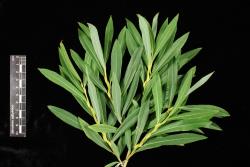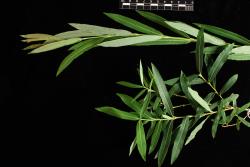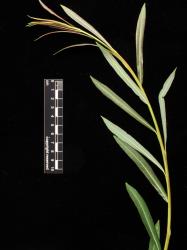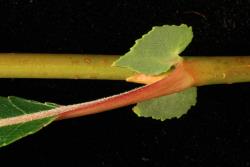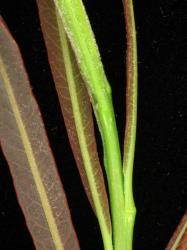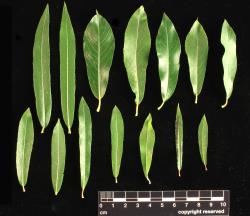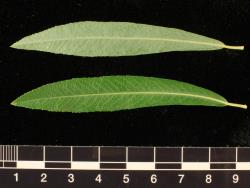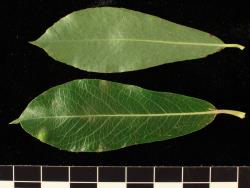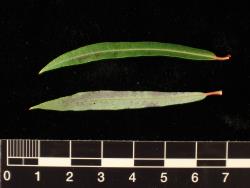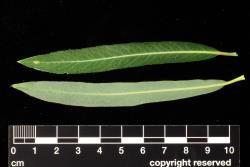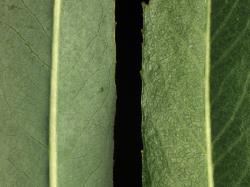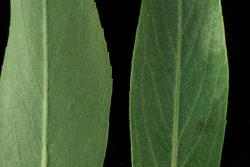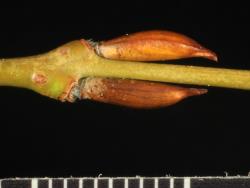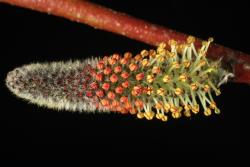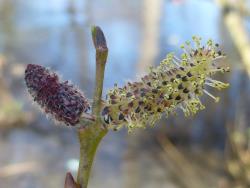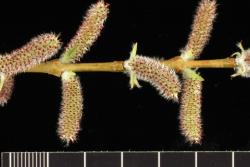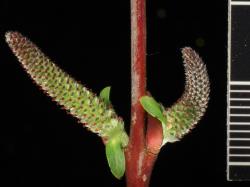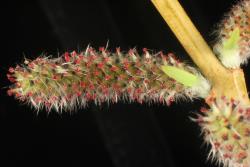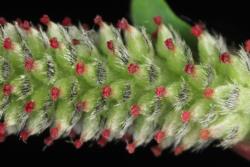A multi-branched shrub, bark not fissured, wood ridges absent. Current year's branchlets glabrous, usually green, sometimes tinted with greyish reddish orange (UCL39). Year-old branchlets greyish yellow (UCL90), glabrous, 1.8–3.0 mm diameter. Bud scales 5.7–7.5 mm long, 2.0–2.3 mm wide, 1.9–2.4 mm deep, narrowly ovoid and spooned at apex, lacking 2 angles, brownish orange, glabrous. Leaves a mixture of alternate and opposite, with a stem buttress below each leaf. Stipules absent. Petiole 3–13 mm long, densely villous at inner base only, glands absent, base of petiole yellow-green. Emerging leaves green or tinted pink or red, glabrous, very sparsely long-silky hairy, or with a dense tomentum that is immediately lost on unfurling of the leaf. Proximal leaves entire. Leaf lamina 45–170 mm long, 7–26(32) mm wide, length to width ratio (3.7)4.0–9.0:1, very narrowly obovate, not falcate; base cuneate, rarely rounded; apex acuminate; leaf galls absent; orange rust absent in late summer; margins distantly serrate or entire, flat; upper lamina surface midvein often raised, slightly glossy, glabrous, stomata sparse to dense; lower lamina surface midvein raised or not, netted veins visible, not glaucous to distinctly glaucous, glabrous. Catkins female or male, emergence precocious, coetaneous, or serotinous with leaves. Flowering branch 21–26 mm long with 2–4 leaves on flowering branch. Male catkin 21–36 mm long, 7–9 mm diameter; catkin rachis usually not visible between flowers. Female catkin 16–22 mm long, 5.5 mm diameter. Flower bract 1.0–2.9 mm long, 0.6–1.1 mm wide, black in upper half, crimson at middle, hyaline at base, flat; apex rounded, sometimes obtuse or acute; densely long-silky hairy all over; female bracts persistent. Male nectary 1, 0.3–0.5 mm long, 0.2–0.4 mm wide, yellow, green, or red. Stamen 1, filaments fused, hairs present at base; anthers 0.6 mm long, red. Female nectary 1, 0.3–0.5 mm long, 0.3 mm wide, yellow or red; ovary 2.4 mm long, densely short-silky hairy, equal in length to flower bract, sessile or stipe 0.1 mm long; style base 0.4 mm long; style arms 0.3 mm long, a groove between the stigmatic surfaces but not lobed, red.
An easily recognised species by the following features. Leaves and branchlets are glabrous. Branchlets are small in diameter (2 mm or less). Leaves are entire or distantly serrate; there are nearly always some opposite leaves on a branchlet, and catkins may also be opposite. Stipules are absent. There is only one stamen filament. Ovaries are densely hairy, almost sessile, and there is only a very short style base, and style arms are red and not lobed.
Year-old branchlets may be glaucous; their colour is variable: sometimes red but often dark yellow (similar in colour to branchlets of Salix ×pendulina f. pendulina). New branchlets are green or red and glabrous. Bud scales are red, both flowering and leaf bud scales rather small and 'spooned' at the apex. Leaves are usually opposite and alternate on the same plant, but in some plants all leaves are alternate. There is a conspicuous leaf buttress. Stipules are absent, even from the youngest leaves. Leaves are narrowly obovate (less often narrowly ovate or narrowly elliptical), margins plane, distantly serrulate and often entire in the basal ⅓. Petiole is usually short (ca. 4 mm long) and lacks glands. The leaf base is usually rounded. Leaves are glabrous except for the inner base of the petiole (rarely hairs extend along the upper surface midvein). They are usually slightly to distinctly glaucous below; stomata are usually dense on the upper surface and are sometimes confined to near the midvein, but are never as dense as on the lower surface. Leaves are only slightly glossy above, the midvein raised both above and below, the secondary veins often slightly raised on both sides. Leaf galls are absent. Emerging leaves can be dark-red tinted and may have a moderately dense tomentum that does not persist. Catkins are short (16–36 mm long) and cylindrical (rather than narrowly conoidal). Flower bracts are obtuse at their apex, initially red but turning black in the distal half, only partly obscured by hairs. In male flowers, at or after anther dehiscence, the flower bract curves downwards to show the black inner surface of the bract. Anthers are red before opening and may be fused or separate but joined to the single filament so as to appear single.
A valued basket-weaving willow, with many named cultivars present in New Zealand (e.g. 'Booth', 'Green Dicks', 'Lancashire Dicks', 'Leicestershire Dicks', 'Goldstones', 'Holland', 'Irette', 'Japonica', 'Nana', 'Pohangina', 'Schultz'). 'Booth' is a sterile female clone (Kuzovkina 2015) often grown in New Zealand. The many cultivars make S. purpurea a very variable species in New Zealand.
Red anthers are common in shrub willows, but only Salix gracilistyla (including the cultivar 'Melanostachys', and the hybrids S. ×forbyana and S. ×sordida × S. gracilistyla) share with their S. purpurea parent the feature of having a single filament per flower. Salix purpurea is more consistently glabrous and has fewer marginal teeth than any other willow species or hybrid in New Zealand. Salix eleagnos and S. viminalis have similarly narrow leaves, but the leaf under-surfaces are moderately densely hairy and the margins are recurved.
Similar in leaf size and shape to Salix acutifolia, also a shrub species with glaucous leaves. The flower bud scale is similar in both. When male flowers are present the difference is obvious: S. acutifolia has two stamens, not one. Female flowers also differ: the ovary of S. acutifolia is glabrous (densely hairy in S. purpurea). Also similar to Salix petiolaris, which has narrow, glabrous leaves, but the leaves of S. petiolaris are densely serrated and stipules are persistent.
Four hybrids in New Zealand have S. purpurea as a parent: S. ×dichroa (with S. aurita), S. ×forbyana (with S. viminalis), S. ×rubra (with S. viminalis), and S. ×sordida (with S. cinerea). The leaves of S. ×sordida are elliptical (not narrowly obovate), and wider, 26–34 mm wide (not 7–22 mm wide). In Salix ×forbyana the flower bracts are more strongly recurved than in S. purpurea. The stamens, nectaries, and anthers appear much the same in both (single red nectaries, red anthers), but S. ×forbyana has very short (0.1 mm long) hairs on the base of the filament, while S. purpurea has short-silky hairs (0.3 mm long) at the base. The leaves of Salix ×dichroa (S. aurita × S. purpurea) resemble those of S. purpurea in being sometimes opposite, entire, small, dull above and glaucous below. The presence of brown hairs on the emerging leaves is the best indication of this hybrid.
Naturalised in Auckland (Auckland City 1989, Kaueranga River 1983), Gisborne (Takaputahi River 1975, Houpoto 1994), Taranaki (Aberfeldy 2014, Kawhātau River 1995), Southern North Island (Hutt River 1953), Canterbury (Conway River 1996, Coutts Island 1964, Cave Stream 1987–2016, Coleridge village 1964). Chatham Island (2007).
First collection: CHR 188361, A. J. Healy 63/372 & I. Fryer, 6 September 1963, Canterbury, Waimakariri River, The Groynes.
First publication: Healy 1968.
Flowering: Mid-October–mid-December.
Diploid, 2n = 38 (CCDB, based on 18 counts), provisionally confirmed using flow cytometry with PN221, PN605 ('Holland'), PN608 ('Irette'), PN611 ('Lancashire Dicks'). However, PN249 'Booth' was tetraploid, and PN662 'Japonica' was triploid, indicating that some Salix purpurea clones may be hybrids.



